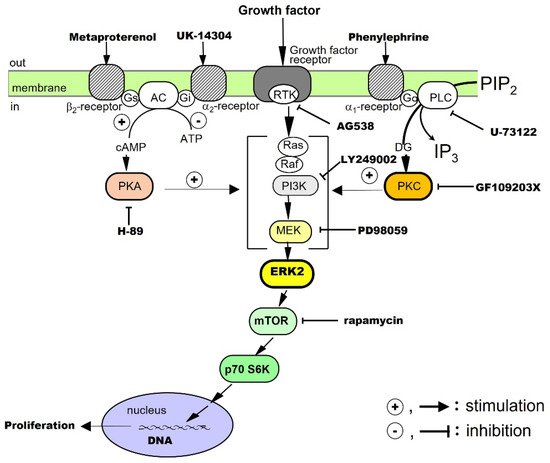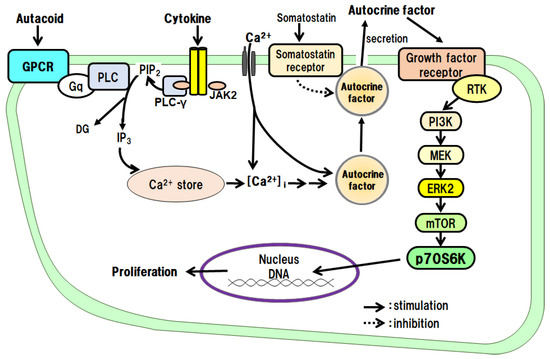Researchers have studied whether growth factors, cytokines, hormones, neurotransmitters, and local hormones 研究者らは、成長因子、サイトカイン、ホルモン、神経伝達物質、および局所ホルモン(autacoids) promote the proliferation of hepatic parenchymal cells (i.e., hepatocytes) using in vitro primary cultured hepatocytes. The indicators used for this purpose include changes in DNA synthesis activity, nuclear number, cell number, cell cycle, and gene expression. In addition, the intracellular signaling pathways from the plasma membrane receptors to the nucleus have been examined in detail for representative growth-promoting factors that have been found to promote DNA synthesis and cell proliferation of hepatocytes.オータコイド)が、in vitro初代培養肝細胞を使用して肝実質細胞(すなわち肝細胞)の増殖を促進するかどうかを研究しました。この目的で使用される指標には、DNA合成活性、核番号、細胞数、細胞周期、および遺伝子発現の変化が含まれます。さらに、原形質膜受容体から核への細胞内シグナル伝達経路について、肝細胞のDNA合成と細胞増殖を促進する代表的な増殖促進因子について詳細に調べています。
- cytokine
- growth factor
- hepatocyte proliferation
- direct mitogen
- indirect mitogen
- co-mitogen
- autocrine mechanism
- signaling pathway
1. Introductionイントロダクション
2. Classification and Characteristics of Hepatocyte Growth Regulators肝細胞増殖調節因子の分類と特徴
Mitogens can be defined as factors that promote the proliferation of hepatocytes by themselves, such as EGF, TGF-α, HGF, platelet-derived growth factor (PDGF), and IGF-I. Co-mitogens, by themselves, do not promote hepatocyte proliferation, but, when used in combination with mitogens, the co-mitogens enhance the activity of the mitogens, and these include adrenergic α- and β-agonists and glucagon. In addition, there are many indirect mitogens, such as TNF-α, IL-1β, prostaglandin (PG) E
マイトジェンは、EGF、TGF-α、HGF、血小板由来増殖因子(PDGF)、IGF-Iなど、それ自体で肝細胞の増殖を促進する因子として定義することができる。コマイトジェンは、それ自体では肝細胞の増殖を促進しませんが、マイトジェンと組み合わせて使用 すると、コマイトジェンはマイトジェンの活性を増強し、これらにはアドレナリン作動性αおよびβアゴニストおよびグルカゴンが含まれます。さらに、TNF-α、IL-1β、プロスタグランジン(PG)Eなどの多くの間接マイトジェンがあります。2, 5-HT, and GH, which indirectly promote hepatocyte proliferation by secreting autocrine factors. In contrast, some factors, such as transforming growth factor-β1 (TGF-β1) and glucocorticoids, strongly suppress mitogen-induced hepatocyte proliferation (i.e., they are inhibitory factors).
、5-HT、およびGHは、自己分泌因子を分泌することによって肝細胞の増殖を間接的に促進する。対照的に、形質転換成長因子-β1(TGF-β1)やグルココルチコイドなどのいくつかの因子は、マイトジェン誘導肝細胞の増殖を強力に抑制します(すなわち、それらは抑制因子です)。2.1 Mitogensマイトジェン
2.1.1 Direct Mitogens直接マイトジェン
EGF
ティッカー
EGF is a protein with a molecular weight of approximately は分子量約6 kDa, and it has three disulfide bonds. EGF binds to the EGF receptor kDaのタンパク質で、3つのジスルフィド結合を持っています。EGFはEGF受容体(EGFR) and activates intracellular signaling pathways by phosphorylating the receptor tyrosine kinase (RTK); the EGF receptor is phosphorylated in vivo 30–60 min after PHx [3]. The prolに結合し、受容体チロシンキナーゼ(RTK)をリン酸化することによって細胞内シグナル伝達経路を活性化します。EGF受容体は、PHxの30〜60分後にin viferative effects of oでリン酸化されます[3]。 肝細胞に対するEGF on hepatocytes have been examined in culture. The results have shown that の増殖効果は、培養で調べられています。その結果、EGF alone promotes DNA synthesis and the proliferation of hepatocytes. It has been suggested that RTK, extracellular signal-regulated kinase (ERK), and the mammalian target of rapamycin 単独ではDNA合成と肝細胞の増殖が促進されることが示されています。RTK、細胞外シグナル調節キナーゼ(ERK)、およびラパマイシンの哺乳類標的(mTOR) are involved in the signaling [8]. Noradrenaline and an adrenergic がシグナル伝達に関与していることが示唆されています[13]。ノルアドレナリンとアドレナリン作動性β2 receptor agonist, on their own, do not promote hepatocyte proliferation, but these agents enhance the growth-promoting effects of 受容体アゴニストは、それ自体では肝細胞の増殖を促進しないが、これらの薬剤はEGF. Thus, there is crosstalk between the adrenergic の増殖促進効果を高める。したがって、アドレナリン作動性β間にクロストークがあります2 receptor-mediated signaling system and the 受容体媒介シグナル伝達系およびEGF receptor-mediated signaling system 受容体媒介シグナル伝達系(Figure 図1).。
TGF-α
TGF-α
TGF-α is a protein with a molecular weight of approximately は分子量約5.5 kDa, which has high amino acid homology with EGF and binds to のタンパク質で、EGFと高いアミノ酸相同性を持ち、EGFR/ErbB1. After receptor dimerization, TGF-α activates RTK, which, in turn, activates the mitogen-activated protein (MAP) kinase cascade via Smad, an adaptor protein, for intracellular signal transduction [9]. に結合します。受容体二量体化後、TGF-αはRTKを活性化し、RTKは次に、細胞内シグナル伝達のためにアダプタータンパク質であるSmadを介してマイトジェン活性化タンパク質(MAP)キナーゼカスケードを活性化します[35]。ケラチノサイトやさまざまな癌細胞によって産生されるサイトカインであるTGF-α, a cytokine produced by keratinocytes and various cancer cells, directly promotes は、培養中の肝細胞単独のDNA synthesis and the proliferation of hepatocytes alone in culture [10]. It is also an autocrine factor secreted by hepatocytes in response to several cytokines 合成と増殖を直接促進します[19]。また、いくつかのサイトカインに応答して肝細胞によって分泌される自己分泌因子でもあります(see below以下を参照).。 肝細胞に対するThe effects of TGF-α on hepatocytes have been investigated in culture. The results have shown that TGF-α alone promotes DNA synthesis and the proliferation of hepatocytes and that RTK, phosphatidylinositol-3 kinase GF-αの効果は、培養において調査されています。その結果、TGF-α単独ではDNA合成と肝細胞の増殖が促進され、RTK、ホスファチジルイノシトール-3キナーゼ(PI3K), ERK, and mTOR are involved in its signal transduction. In addition, adrenergic 、ERK、およびmTORがそのシグナル伝達に関与していることが示されています。さらに、アドレナリン作動性α1 receptor agonists enhance the effects of 1受容体アゴニストはTGF-α, suggesting crosstalk with adrenergic の効果を増強し、アドレナリン作動性αとのクロストークを示唆している1 receptor-mediated signaling pathways 受容体媒介性シグナル伝達経路(Figure 図1).。HGF
ティッカー
HGF is a protein consisting of は、728 amino acids and a heterodimeric structure, with a heavy chain of approximately 個のアミノ酸とヘテロ二量体構造からなるタンパク質で、重鎖は約60 kDa and a light chain of 、軽鎖は約3.5 kDa. It is a cytokine produced by stellate cells and endothelial cells in the liver. Its receptor is cMet, which dimerizes and activates the RTK in the intracellular domain to mediate the action of the HGF [11][12][13].です。肝臓の星細胞や内皮細胞が産生するサイトカインです。その受容体はcMetであり、細胞内ドメインのRTKを二量体化および活性化してHGFの作用を媒介します[36,37,38]。 The proliferative effect of 肝細胞に対するHGF on hepatocytes has been examined in culture. The results have shown that HGF alone promotes DNA synthesis and the proliferation of hepatocytes and that RTK, PI3K, ERK, and mTOR are involved in its signaling [14]. Researchers have also found that both adrenergic の増殖効果は、培養において調べられている。結果は、HGFのみがDNA合成と肝細胞の増殖を促進し、RTK、PI3K、ERK、およびmTORがそのシグナル伝達に関与していることを示しています[20]。我々はまた、アドレナリン作動性α1 and およびβ2 receptor agonists potentiate the growth-promoting effects of 受容体アゴニストは、クロストークによってHGF by crosstalk の成長促進効果を増強します(Figure 図1).。PDGF
PDGF belongs to the PDGF/VEGF family. Its molecular weight is approximately 30 kDa, and its A and B chains form homo- and hetero-dimeric structures (PDGF-AA, PDGF-BB, and PDGF-AB), which activate RTK for intracellular signal transduction [15][39]. It was first isolated from platelets, but it is also produced by macrophages, vascular endothelial cells, smooth muscle cells, and cancer cells. In addition to PDGF, the platelets also contain TGF-β1, HGF, and 5-HT, which are released during the platelet adhesion and aggregation associated with tissue injury [3]. The released PDGF is thought to trigger a series of responses including inflammation and macrophage, neutrophil, and fibroblast migration. RWesearchers investigated the proliferative effects of PDGF on hepatocytes in culture. The results showed that PDGF-BB alone promotes DNA synthesis and proliferation of hepatocytes and that RTK, PI3K, ERK, and mTOR are involved in its signal transduction [16][21]. In addition, an adrenergic α1 receptor agonist enhances the effects of the PDGF-BB, suggesting crosstalk with adrenergic α1 receptor-mediated signaling pathways (Figure 1).Insulin
Human insulin is a heterodimer consisting of an A chain of 21 amino acids and a B chain of 30 amino acids, joined by two disulfide bonds. It is produced by pancreatic B cells and can always act on the liver via the portal bloodstream. The receptor for insulin is a built-in tyrosine kinase, and its activation phosphorylates its intracellular substrate, insulin receptor substrate-1 (IRS-1). Subsequently, signals are transmitted to PI3K and protein kinase B, and glucose transporter-4 is translocated to the cell surface. It has also been reported that blood levels of insulin increase soon after PHx [17][40]. The proliferative effect of insulin on hepatocytes has been said to be a co-mitogen that enhances the action of direct mitogens such as EGF. Therefore, rwesearchers investigated the effects of insulin in culture. TheOur results showed that insulin alone promotes DNA synthesis and hepatocyte proliferation and that RTK, PI3K, ERK, and mTOR are involved in its signaling [18][19][22,41]. In addition, an adrenergic α1 receptor agonist potentiates the action of insulin, suggesting crosstalk with adrenergic α1 receptor-mediated signaling pathways (Figure 1).2.1.2. Co-Mitogens
Noradrenaline
Noradrenaline is a sympathetic neurotransmitter with a catecholamine structure. Noradrenaline receptors include adrenergic α and β types, each of which has subtypes. All the receptors for noradrenaline are G-protein-coupled ones. It has been reported that sympathetic hyperactivity due to post-PHx invasion increases the blood levels of noradrenaline in about 1 h [20][42]. It activates the duodenal Brunner’s gland and stimulates EGF production and HGF expression [21][22][43,44]. In primary cultured hepatocytes, noradrenaline alone does not promote the proliferation of hepatocytes, but, through crosstalk, it can enhance the hepatocyte proliferation-promoting effects of EGF [8][13], TGF-α [10][19], HGF [14][20], PDGF [16][21], and insulin [19][22] (Figure 1). In addition, in combination with phenylephrine (a selective adrenergic α1-receptor agonist), it enhances the hepatocyte-proliferative effects of EGF, HGF, TGF-α, PDGF, and insulin. Metaproterenol (a selective β2-receptor agonist) enhances the proliferative action of EGF, IGF-I, and HGF. These results show that noradrenaline exhibits unique regulatory mechanisms for these growth factors.2.1.3. Indirect Mitogens
IL-1β
IL-1β was the first inflammatory cytokine among the ILs to be identified, and there are two types, IL-1α and IL-1β [23][45]. IL-1β is a protein consisting of 110–140 amino acids. IL-1 receptors are highly homologous to toll-like receptors and activate serine/threonine kinases via adaptor proteins for intracellular signal transduction. IL-1 is rarely detected in normal tissues and is produced and secreted by macrophages and other immune cells activated by infiltrating inflammation. It has proliferative effects on monocytes and granulocytes. The proliferative effects of IL-1β on hepatocytes have been examined in culture. The results have shown that IL-1β alone promotes DNA synthesis and the proliferation of hepatocytes and that the IL-1β effects are mediated via autocrine secretion of TGF-α from hepatocytes (Figure 2) [24]. IL-1α does not promote the proliferation of hepatocytes.
